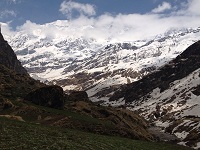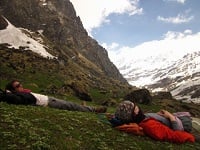 Here is the reason not to go to India: Eat, Pray, Love. These are not my words. These are the words of the three delightful embassy workers I had dinner with on my second night in New Delhi. When I asked them what the most common problem Americans had when coming to India (I thought lost passports would be up there), in unison they all responded, “Eat, Pray, Love.” It seems that the book (and then later the movie) inspired many Americans (young and old, male and female) to travel to India to “find themselves”, where they then visited extremely remote ashrams, took lots of drugs (the Tantras are apparently very big with this) and then landed themselves in jail. The ladies asked that I kindly not try to find myself in India, and if I absolutely must, that I do so without the aid of an insane amount of drugs. I told them, no problem. I live in Berkeley where within a two block radius of my house I could easily find both.
Here is the reason not to go to India: Eat, Pray, Love. These are not my words. These are the words of the three delightful embassy workers I had dinner with on my second night in New Delhi. When I asked them what the most common problem Americans had when coming to India (I thought lost passports would be up there), in unison they all responded, “Eat, Pray, Love.” It seems that the book (and then later the movie) inspired many Americans (young and old, male and female) to travel to India to “find themselves”, where they then visited extremely remote ashrams, took lots of drugs (the Tantras are apparently very big with this) and then landed themselves in jail. The ladies asked that I kindly not try to find myself in India, and if I absolutely must, that I do so without the aid of an insane amount of drugs. I told them, no problem. I live in Berkeley where within a two block radius of my house I could easily find both.
Here is the reason to go to India: Glaciers. Now I know you are probably thinking that with several thousand years of complex religious and political history, bustling markets with everything from fabulously bejeweled Saris to nausea-inducing butcheries (check out backside of the Crawford market in Mumbai) and the most breath-taking man-made structure in the world – the Taj Mahal – that I would have to be crazy to overlook them for something as boring as a glacier. But let me tell you, having now seen glaciers in Northern India; glaciers are huge, they are important and when you go see them, they will literary knock your socks off.
As a scientist with an interest in both soils and climate change (and a former New England resident who was never able to grow a straight carrot due to rocky soils derived from glacial till), seeing a glacier is like coming home for the very first time. (When we got to the first glacier, I jumped up and down and shouted “This is how soil is made!! This is how soil is made!!”) But you probably already know that glaciers build soil, are large repositories of fresh water and their melting will increase sea levels globally. So I won’t bore you with the basics.
 Ironically, among the many global impacts glaciers have on water availability and climate, it’s actually their current chilly existence that is keeping places like Europe so mild and toasty warm.
Ironically, among the many global impacts glaciers have on water availability and climate, it’s actually their current chilly existence that is keeping places like Europe so mild and toasty warm.
A prime example are the the glaciers in Greenland that everyone is always griping about. If these glaciers melt, icy fresh water will enter the Atlantic ocean and disrupt the Atlantic Meridional Overturning Circulation (AMOC). AMOC is an ocean conveyor belt that moves warm water from the equator to Northern regions and brings cold water from the North back down to the equator (click here for a cool video).
This movement of heat through the oceans actually helps warm Europe, making it the lovely, temperate place that made me curse the Spanish every winter when they were toasty warm and I was a frosty little ice cube living at the same latitude in Boston (snooty Europeans with their awesome weather, grrr). Turns out latitude isn’t everything, the AMOC is important too. And if the AMOC slows down, Europe could become a little frosty too (1).
This cooling of Europe from a slowing of the AMOC has been seen before, a loooong time ago in an era known as the Younger Dryas or the Big Freeze which occurred about 12,000 years ago (dramatized more hilariously in the movie The Day After Tomorrow). This led to a massive cool down of the North, with a summer temperature in central Europe of about 50 degrees F (2). Suckers.
For those of you who just purchased a summer bungalow in southern Spain anticipating a toasty warm retirement, never fear! Most experts in the field believe that we will be faced with a slowdown of the AMOC, rather than a complete shutdown (3). Moreover, NASA has predicted that the 5 degree cooling Europe might see from the slowing of the AMOC will be more than offset by global warming predicted for the same region (4) – thank God for global warming? So just rev up your SUVs, keep burning coal, maybe even plan a trip to see some glaciers yourself in India…. just plan to buy a retirement home a little more inland – who knows, it might be lovely beach front property by 2100.
For your reading enjoyment:
(1) Potential climatic transitions with profound impact on Europe
(2) Mean July Temperatures during the Younger Dryas in Northwestern and Central Europe as Inferred from Climate Indicator Plant Species
(3) Expert judgements on the response of the Atlantic meridional overturning circulation to climate change
(4) Ocean Motion and Surface Currents
 Minda Berbeco just hiked the Himalayas in Northern India, evading certain death twice. While there she traversed ice flows, drank tea in mountain huts, hunted pika and was chased by several toddlers seeking Kit Kat bars (who would’ve guessed they’d be so popular there??).
Minda Berbeco just hiked the Himalayas in Northern India, evading certain death twice. While there she traversed ice flows, drank tea in mountain huts, hunted pika and was chased by several toddlers seeking Kit Kat bars (who would’ve guessed they’d be so popular there??).